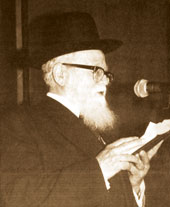Beit Midrash
- Sections
- Chemdat Yamim
- Parashat Hashavua
- Torah Portion and Tanach
- Vayikra
- Behar
There are two ways of looking at these laws, especially when one views all elements as linked (and do not just happen to overlap chronologically). The Sefer Hachinuch (mitzva 330) champions the approach that the focus is on heightening our realization that the Creator of the World owns everything, so that none of our personal acquisitions and financial rights are permanent but will get returned to their original state. Our slaves are not ours; we can work our own fields only when and how Hashem allows; fields we acquired cease to be ours. Hashem is everything, and we are His slaves, who lack full ownership of anything. In this way, Yovel is a continuation and escalation of Shemitta, which it follows. (Abarbanel points out that when refraining from working the land during Shemitta, the Torah refers to "your field," "your vineyard," whereas during Yovel one is not to harvest "its growth.")
The simpler approach is that Yovel focuses on a high level of social equality. One must return the field that he acquired legally from someone else. Usually, this happened when he had to pay debts with the proceeds of the sale, and he became landless. One must allow his legal slave to go free. This also usually happened when poverty pushed one’s fellow man to sell himself or led him to thievery for which he was sold when he couldn’t pay back that which he stole. One must allow these people to go back to their freedom and their field, respectively, with the hope that they learned how to do things in a better way and/or will merit more Divine Assistance than they did the first time around.
One indication that points to the strength of the second approach is the halacha that even a Jewish slave who is sold to a non-Jewish buyer goes free during Yovel (Rambam, Avadim 2:6). In that case, the Torah has in mind the benefit of the Jewish slave, not his non-Jewish owner. On the other hand, what does the Shemitta of the land have to do with people returning hope to the poor?
The simplest and most likely answer is that the two approaches are not contradictory but complementary; elements of both approaches are true. But there is another possibility with fascinating implications. When a slave is set free, he is certainly starting behind others. He needs time to get accustomed to financial responsibilities that he previously failed at. He has not prepared his field for harvest and is likely to fall behind again. Therefore, he is released during Yovel, the second straight year of Shemitta. He is in the same boat with everyone else, who struggle with the challenges of Shemitta and share produce. By year’s end, he and everyone else go back to working their fields and preparing for a brighter future.

Parashat Hashavua: Who Called Out to Whom?
Rabbi Yossef Carmel | Nisan 5785

Parashat Hashavua: Can One Give a Loan to Hashem? – part II
Rabbi Yossef Carmel | Elul 5785

Parashat Hashavua: 137 and the Power of Uncertainty
Rabbi Yossef Carmel | Cheshvan 5786

Why Do Children Start With Vayikra?
Rabbi Shaul Yisraeli zt"l | 5771

Rabbi Daniel Mann

Washing Hands with Soap on Yom Kippur
Tishrei 4 5776

Making Sure your Check Is Cashed
Kislev 5783

Timtum Halev – Part II
Adar I 8 5776





















